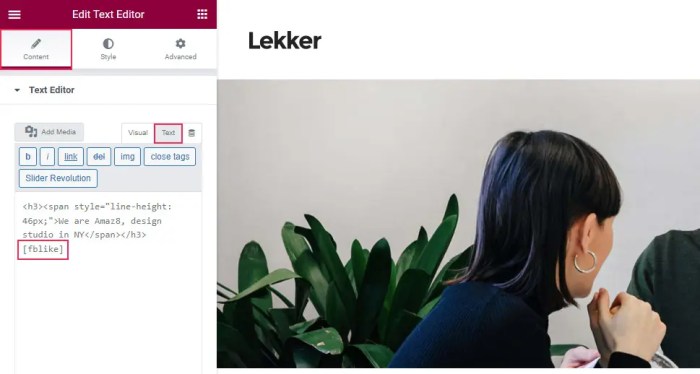How to add Facebook like button in WordPress? This guide walks you through seamlessly integrating a Facebook Like button onto your WordPress site. We’ll explore various methods, from user-friendly plugins to in-depth code customization, ensuring your site gains valuable social engagement and boosts traffic.
Whether you’re a beginner or a seasoned WordPress user, this comprehensive guide provides clear steps and practical examples to help you add a Facebook Like button to your website, tailored to match your specific needs and technical comfort level.
Introduction to Facebook Like Button Integration

Adding a Facebook Like button to your WordPress website is a straightforward way to encourage social interaction and potentially boost your website’s visibility. This integration allows visitors to express their interest in your content by clicking the Like button, sharing it with their Facebook friends, and increasing your website’s presence on the platform. It’s a crucial part of any modern online strategy aiming for greater engagement and reach.Social media integration is vital for any website aiming to attract new visitors and maintain a loyal audience.
It facilitates easy sharing, driving traffic from social networks to your site. This increased traffic can lead to higher conversion rates and greater brand awareness. Different methods exist for integrating social media buttons, ranging from manually embedding code to utilizing plugins and themes.
Different Ways to Integrate Social Media Buttons
Integrating social media buttons can be achieved through various methods. One common approach is using dedicated plugins, which often provide a user-friendly interface for selecting and placing buttons on your site. Alternatively, you can manually embed code snippets from the social media platform directly into your WordPress theme’s code. Themes themselves sometimes incorporate social media integration options, simplifying the process further.
Choosing the right method depends on your technical proficiency and the level of customization you require.
Benefits of Using a Facebook Like Button
The Facebook Like button offers several advantages that contribute to a website’s overall success. It encourages social sharing, allowing your content to reach a wider audience. This expanded reach, in turn, can attract more organic traffic to your site, which is essential for building brand recognition. Increased visibility on Facebook can also generate more leads and potential customers.
Furthermore, the button provides valuable insights into user engagement with your content. Tracking the number of likes provides data about which content resonates most with your audience, offering opportunities for further optimization.
Types of Facebook Like Buttons
Facebook offers various types of Like buttons, each serving a specific purpose. The standard Like button is the most common, allowing users to express their interest. A ‘Send’ button enables users to share the link with friends directly through Facebook. A ‘Recommend’ button encourages users to recommend the page or post to their network. These different button types cater to different engagement goals and user behaviors.
Factors to Consider When Choosing a Facebook Like Button
Several factors influence the choice of a Facebook Like button. The desired level of engagement is a key consideration. If your primary goal is driving traffic and brand awareness, the standard Like button may suffice. For more complex engagement strategies, such as promoting specific calls to action or direct sharing, the ‘Send’ or ‘Recommend’ buttons may be more appropriate.
Furthermore, consider the design aesthetic of your website; the button should seamlessly integrate with the overall visual identity. Ensuring compatibility with your WordPress theme and plugins is also crucial to prevent conflicts and ensure smooth functionality.
Choosing the Right Method for Integration

Adding a Facebook Like button to your WordPress site can significantly boost social engagement. However, several methods exist, each with its own set of advantages and disadvantages. Understanding these differences is crucial for selecting the optimal approach for your specific needs and technical expertise.Choosing the right integration method hinges on factors like your technical skills, desired level of customization, and the overall complexity of your website.
A plugin offers an easier, more user-friendly approach, ideal for beginners. Conversely, custom code allows for maximum control and customization but requires more technical expertise. This section explores the various integration methods, comparing their strengths and weaknesses to help you make an informed decision.
Plugin Integration
WordPress plugins are pre-built solutions that streamline the process of adding Facebook Like buttons. They typically require minimal technical knowledge, making them accessible to a wider range of users. These solutions often include a variety of customization options, such as choosing the button style, size, and positioning.
- Ease of Use: Plugins are generally straightforward to install and activate. Instructions are often clear and concise, making them ideal for users with limited technical experience. Most plugins have intuitive interfaces that allow for easy configuration.
- Customization Options: Plugins often provide a range of customization options. You can typically select the button’s appearance, adjust its size, and potentially tailor its placement on the page. These features are generally well-documented within the plugin’s settings.
- Technical Requirements: Plugins typically have minimal technical requirements. They are designed to integrate seamlessly with WordPress, handling the necessary code behind the scenes. The process is usually straightforward, involving just a few clicks.
Code Integration
Employing custom code offers greater flexibility and control over the button’s appearance and functionality. While demanding a higher level of technical expertise, this approach empowers you to tailor the button precisely to your site’s design.
- Ease of Use: Implementing custom code requires a deeper understanding of HTML, CSS, and JavaScript. The process might be more challenging for beginners compared to using a plugin. Thorough knowledge of these languages is essential for successful implementation.
- Customization Options: Custom code allows for highly granular control over every aspect of the button’s appearance and behavior. You can modify the button’s styling, add custom JavaScript functionality, and perfectly align it with your site’s design. The extent of customization is practically limitless.
- Technical Requirements: Custom code integration demands a strong understanding of web development concepts. This method requires familiarity with WordPress themes, code editing, and the technical details of Facebook’s Like button API. Careful attention to detail is crucial to avoid errors and ensure smooth functionality.
Comparison Table
| Integration Method | Ease of Use | Customization Options | Technical Requirements |
|---|---|---|---|
| Plugin | High | Medium | Low |
| Code | Low | High | High |
Using WordPress Plugins for Integration: How To Add Facebook Like Button In WordPress
WordPress plugins offer a streamlined approach to integrating Facebook Like buttons. They handle the technical complexities, allowing you to focus on design and content. Choosing a reputable plugin saves you time and effort while ensuring compatibility with your WordPress site.Using plugins simplifies the process significantly. Instead of manually coding the button, you install and configure a plugin.
This often involves fewer steps and less technical expertise, making it a user-friendly option for those less comfortable with coding.
Plugin Installation and Activation
Installing a WordPress plugin is a straightforward process. First, navigate to the Plugins section in your WordPress dashboard. Then, click the “Add New” button. Search for the desired plugin using the search bar. Select the plugin and click “Install Now.” After installation, activate the plugin by clicking the “Activate” button.
Popular Plugins for Facebook Like Buttons
Several popular and well-regarded plugins handle Facebook Like button integration. Some highly-rated options include the “Like Button for WordPress” plugin, which provides a simple interface for adding the button to your site. Another option is the “Social Warfare” plugin, which offers a comprehensive suite of social sharing options, including the Facebook Like button. Consider carefully the specific features needed for your site when choosing a plugin.
Plugin Configuration for Optimal Display
Once the plugin is activated, you’ll typically find configuration settings within the plugin’s dashboard. These settings often allow you to customize the button’s appearance, such as the color, size, and shape. You can often adjust the button’s display to match your site’s theme. This customization often allows you to tailor the button to complement your site’s overall design.
Customizing the Plugin’s Settings
Plugins usually offer various customization options. For example, you might be able to choose different button styles or specify whether the button displays a count of likes. The specific customization options available will depend on the chosen plugin. Detailed configuration instructions are typically provided within the plugin’s documentation.
Displaying the Button on Specific Pages or Posts
Most plugins allow you to target the placement of the Facebook Like button to specific pages or posts. This targeted approach ensures that the button appears only where appropriate, enhancing the user experience. Instructions for targeting specific pages or posts are usually straightforward and clearly Artikeld within the plugin’s documentation. This approach also allows for greater control over the user experience.
Implementing the Facebook Like Button via Code
Adding a Facebook Like button directly to your WordPress site through code provides a more customized approach, allowing for greater control over the button’s appearance and behavior. This method is ideal for those who want granular control over the button’s placement, styling, and functionality. It also offers flexibility to integrate with themes that might not support plugin-based solutions.
Using Shortcodes for Integration
Shortcodes offer a straightforward way to embed the Facebook Like button within WordPress posts and pages. This method leverages the power of shortcodes, which are reusable blocks of code that can be easily inserted into content.
- To utilize shortcodes, you’ll need to generate the necessary code for your Facebook Like button from the Facebook Developers website. This process involves specifying the URL of the page or post you want to associate the button with.
- Once you have the code, you can insert it into your WordPress post or page using a shortcode. For example, to add a standard Like button to a specific page, you would use a shortcode similar to this:
[facebook-like-button url="https://www.example.com/page-to-like"] - Different styles of buttons can be achieved by modifying the shortcode parameters. For example, you might add
[facebook-like-button url="https://www.example.com/page-to-like" style="box_count"]for a button displaying the count of likes.
Customizing Button Placement with HTML
The HTML structure surrounding the shortcode dictates where the button appears on your page. Directly integrating the HTML allows for precise positioning and design control.
- By embedding the Facebook Like button’s HTML directly into your WordPress theme’s template files, you gain complete control over its placement and styling.
- The basic HTML structure for a Facebook Like button usually involves an iframe tag, providing a container for the button. You can customize this container to fit your website’s design.
- Positioning the button within a specific div element, for instance, allows for better control over its visual placement, ensuring that it aligns seamlessly with other content elements.
Integrating with JavaScript
JavaScript allows for dynamic interactions and advanced functionalities. You can use JavaScript to trigger actions based on user interaction with the button.
- Integrating JavaScript with the Facebook Like button allows for dynamic interactions, such as displaying real-time updates of the like count. For example, a JavaScript function can update a counter on your site to reflect the current number of likes.
- Using JavaScript, you can handle user interactions, like tracking the number of likes or triggering custom actions within your website’s logic.
- JavaScript can also be employed to modify the button’s appearance, behavior, and responsiveness in response to specific events, creating a more dynamic user experience.
Adapting to WordPress Themes
Modifying the code to integrate with different WordPress themes requires careful consideration of the theme’s structure.
- The process involves understanding the theme’s template files and inserting the Facebook Like button code into the appropriate section to maintain visual consistency with the theme.
- For themes with a well-defined structure, you can insert the shortcode or HTML snippet into specific areas like the header, footer, or sidebar.
- When adapting to a theme, you should always back up your theme’s files before making any changes to avoid unintended consequences.
Code Integration Table
| Code Element | Description |
|---|---|
| HTML (Shortcode) | Embeds the Like button; defines button style, placement, and associated URL. |
| HTML (Custom) | Provides explicit control over button positioning and visual attributes within the page structure. |
| JavaScript | Enables dynamic updates, tracking interactions, and custom functionality related to likes. |
| WordPress Theme Files | Insertion points within theme templates for integrating the button, maintaining consistency with the overall design. |
Customizing the Facebook Like Button Appearance
Once you’ve integrated the Facebook Like button into your WordPress site, you can further enhance its visual appeal to seamlessly match your website’s design. Customizing the button’s appearance allows you to fine-tune its colors, size, shape, and position to create a more integrated and aesthetically pleasing user experience. This section will guide you through the various customization options available.
This customization is achieved primarily through CSS styling. Understanding how to apply these styles ensures that the Facebook Like button blends naturally with your website’s theme, rather than appearing as an outlier. The following sections delve into the specific methods and techniques for achieving this.
Adding a Facebook Like button to your WordPress site is a straightforward process. You can easily find plugins to handle this, making it quick and simple. However, a crucial part of website success isn’t just about social interaction; it’s also about ensuring your site is optimized for search engines. A recent Semrush study on site SEO issues ( semrush study on site seo issues ) highlights the importance of technical SEO in driving organic traffic.
Ultimately, having a well-structured website, with features like Facebook Likes, will improve your site’s performance across the board.
Color Customization
Facebook Like buttons, by default, use Facebook’s brand colors. You can modify these colors to align with your website’s branding or even to create a unique visual identity. This involves changing the button’s background, text, and border colors. For example, a blue button on a website with a predominantly red theme might appear jarring.
Adding a Facebook Like button to your WordPress site is a straightforward process, but securing buy-in for your marketing initiatives, like adding social media engagement tools, often requires a more nuanced approach. Think about how you can clearly articulate the value of a Facebook Like button in terms of increased engagement and potential conversions, just like you would when discussing marketing priorities with stakeholders.
For a deeper dive into getting stakeholders on board with your marketing plans, check out this helpful guide on how to get stakeholder buy in for your marketing priorities. Ultimately, a well-placed Facebook Like button can significantly boost your site’s social presence, and that’s something you can definitely measure and track!
Size and Shape Customization
Modifying the button’s size and shape is another important aspect of customization. You can adjust the button’s dimensions (width and height) and even alter its shape from the standard rectangular format to a more visually engaging design. Adjusting the size can enhance or detract from the overall design, and choosing the right shape can significantly impact the button’s visual appeal.
Positioning the Button
Positioning the button is crucial for optimal visual integration. The button can be positioned above, below, or beside the content it is meant to accompany. This positioning is vital to ensure the button is placed in a location that is easily accessible to users and visually harmonious with the surrounding content. Proper positioning avoids the button appearing out of place.
Text Customization
You can alter the text displayed on the button to match the context of the content or your brand’s voice. This allows for clear communication and a more integrated design. For example, instead of “Like,” you might use a phrase like “Love this!” to encourage interaction. This customized text further reinforces the brand message.
CSS Examples for Button Styles
CSS allows for precise control over the Facebook Like button’s appearance. The following examples demonstrate different ways to style the button using CSS. These examples demonstrate the use of specific CSS properties like `background-color`, `color`, `font-size`, `padding`, `border`, and `border-radius` to modify the button’s appearance. These examples use common CSS properties for a tailored appearance.
.fb-like background-color: #FF0000; /* Red background -/ color: white; /* White text -/ width: 150px; /* Increased width -/ height: 40px; /* Increased height -/ border-radius: 5px; /* Rounded corners -/
These examples demonstrate how to use CSS to adjust the size, color, and shape of the button to create a unique look.
Different properties, such as padding, border width, and border-radius, can be used to fine-tune the appearance even further.
Matching the Button Style with Website Theme
To ensure seamless integration, it’s important to consider the website’s existing color scheme and design elements. This includes choosing colors, sizes, and shapes that complement the overall theme. Matching the button style ensures a cohesive visual experience and strengthens the brand identity.
CSS Attributes and Their Effects on Button Appearance
| CSS Attribute | Effect on Button Appearance |
|---|---|
background-color |
Changes the background color of the button. |
color |
Changes the text color of the button. |
font-size |
Changes the size of the text on the button. |
padding |
Adjusts the space between the button’s text and border. |
border |
Adds or modifies the button’s border. |
border-radius |
Rounds the corners of the button. |
width |
Sets the width of the button. |
height |
Sets the height of the button. |
Troubleshooting Common Issues
Integrating the Facebook Like button into your WordPress site can sometimes encounter snags. This section delves into potential problems and provides practical solutions to common integration errors. Understanding these issues and their resolutions can save you valuable time and effort.Troubleshooting integration issues is crucial for a smooth user experience. Addressing problems like the button not displaying or incorrect code execution helps maintain a functional and aesthetically pleasing website.
This section will provide a structured approach to identify and rectify these issues, covering theme/plugin conflicts and Facebook API problems.
Identifying Display Issues
The Facebook Like button might not appear on your WordPress site for several reasons. Incorrect code implementation, compatibility problems with your theme or plugins, or temporary Facebook API issues are some possibilities. Careful examination of the integration process and its elements is crucial to pinpoint the source of the problem.
Resolving Code Errors
Errors in the code you’ve used to embed the Facebook Like button can prevent its proper display. Carefully review the code for syntax errors, typos, or incorrect placements. Double-check the code against the provided examples, paying close attention to details like opening and closing tags, and ensuring correct API calls.
Addressing Theme and Plugin Conflicts
WordPress themes and plugins can sometimes interfere with the Facebook Like button’s functionality. This interference can stem from conflicting CSS styles or JavaScript code. Temporarily disabling suspect plugins or using a child theme to isolate the problem can help pinpoint the source of the conflict.
Debugging Facebook API Issues
Problems with the Facebook API can lead to display errors or a complete absence of the Like button. Check the Facebook API documentation for any known issues or recent changes. Ensure you have the correct API access permissions and that the app ID and other required information are accurate. Testing the button functionality on a different website or using a temporary API key can also help isolate the problem.
Table of Common Problems and Solutions, How to add facebook like button in wordpress
| Problem | Possible Cause | Solution |
|---|---|---|
| Button not displaying | Incorrect code, theme/plugin conflict, Facebook API issue | Review code for errors, disable plugins temporarily, check Facebook API status, ensure correct app ID and access permissions |
| Incorrect button appearance | Conflicting CSS styles, incorrect button configuration | Inspect CSS for conflicts, review Facebook Like button configuration options, use a child theme if necessary |
| Button not responding | Incorrect JavaScript integration, API limitations | Review JavaScript code for errors, check Facebook API documentation for limitations, test on a different page |
| Error messages | Incorrect app ID, missing permissions, API issues | Verify app ID, ensure correct permissions, check Facebook API status, review error messages for specific details |
Advanced Integration Techniques
Beyond basic integration, the Facebook Like button can be seamlessly integrated with other WordPress functionalities to enhance user engagement and provide richer user experiences. This section explores advanced techniques for integrating the button with custom post types, widgets, and real-time updates. Understanding these methods allows for a more dynamic and tailored integration within your website’s design.Advanced integration techniques go beyond simply placing the Like button on a page.
They leverage WordPress’s flexibility to create more interactive and user-friendly experiences, aligning the Facebook Like button with the unique aspects of your site’s content.
Custom Post Types and Pages
Integrating the Facebook Like button with custom post types or pages provides a targeted approach to engagement. By utilizing custom post types, you can integrate the Like button into content specifically tailored for a particular category or function. This is particularly useful for displaying specific content and promoting user interaction with it. For example, if you have a custom post type for “Events,” you could add a Like button to each event post, allowing users to express interest in specific events.
Adding a Facebook Like button to your WordPress site is a simple process, but sometimes you need a bit more than just the basic plugins. Thinking about how to optimize your site for user engagement, you might consider exploring tools like pendo vs whatfix comparison unleashing nocode growth strategies to help with your user experience.
Ultimately, a strong Facebook presence and well-placed engagement tools can boost your WordPress site’s overall success. So, now you’re equipped to tackle adding that Like button and start building a better online community.
Likewise, integrating the button into custom pages offers a tailored experience for specific topics or promotions.
Integration with Widgets
Widgets offer a flexible way to incorporate the Facebook Like button into specific sections of your WordPress site. Placing the Like button within widgets allows for greater control over the button’s location and appearance, adapting to the layout and design of your website. For example, a widget could be created to display a recent posts section, including a Facebook Like button for each post, encouraging user engagement with recent content.
Real-Time Updates
Real-time updates ensure that the Like count reflects the current number of likes. Implementing this feature dynamically refreshes the displayed count, keeping it accurate and up-to-date. This is a crucial feature for maintaining a live and engaging experience.
Custom Functionalities
Custom functionalities allow you to integrate the Facebook Like button with other custom actions or events on your website. For example, a custom function could be used to trigger a notification or action upon a user liking a particular post. This level of integration provides a powerful tool for implementing tailored experiences based on user actions. Imagine a system where liking a specific post automatically adds it to a user’s “favorites” list.
Making the Count Dynamic
Dynamically updating the Like count is essential for maintaining an accurate representation of user engagement. This involves using JavaScript or other client-side technologies to fetch the real-time Like count from Facebook and display it on your WordPress site. Employing an API call for updates will ensure the button’s count remains current. This can be achieved by using a combination of PHP and Javascript to refresh the count periodically.
Ensuring Compatibility and Best Practices
Adding a Facebook Like button to your WordPress site requires careful consideration of compatibility, performance, and accessibility. Proper implementation ensures a seamless user experience and avoids potential issues with various WordPress versions and browser compatibility. This section details crucial steps for integrating the Facebook Like button effectively.
WordPress Version Compatibility
Compatibility with different WordPress versions is paramount. The Facebook Like button’s functionality and display should remain consistent across different WordPress releases. Testing the button on various WordPress versions, including both recent and older ones, is crucial to identify and resolve potential compatibility issues. Using a plugin or code that is well-maintained and regularly updated helps to mitigate compatibility problems.
This proactive approach ensures the button works seamlessly on a wide range of sites.
Performance Optimization
Optimizing performance is vital to avoid impacting site speed. Heavy scripts or poorly implemented code can lead to slower loading times, negatively affecting user experience. Minimizing the size of the Facebook Like button’s JavaScript files is one approach. Using a content delivery network (CDN) to cache the Facebook Like button resources can further improve loading times. These techniques are essential for delivering a smooth and responsive user experience.
Accessibility Considerations
The Facebook Like button should be accessible to users with disabilities. Properly implementing ARIA attributes or alternative text for images can help screen readers and other assistive technologies to interpret the button’s functionality accurately. Using sufficient contrast between the button’s colors and the background can enhance readability for users with visual impairments. This focus on accessibility ensures inclusivity and improves the user experience for everyone.
Compliance with Facebook’s Terms of Service
Adhering to Facebook’s terms of service is essential for avoiding any account suspension or limitations on functionality. Misuse of the button, such as using it in ways that violate Facebook’s policies, can lead to severe consequences. Understanding and strictly following Facebook’s guidelines ensures smooth integration and continued functionality. Reviewing and understanding Facebook’s policies for the Like button is a vital step in ensuring the button’s continued operation.
End of Discussion
In conclusion, adding a Facebook Like button to your WordPress site is achievable through various methods, each with its own advantages. By understanding the different approaches, from plugins to code, you can choose the best method for your needs. Remember to prioritize customization, compatibility, and best practices to ensure a smooth integration process and enhance your website’s social presence.
This guide provides a solid foundation to help you integrate this valuable social media element into your WordPress site, ultimately boosting engagement and website traffic.






